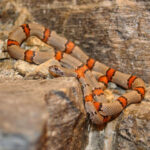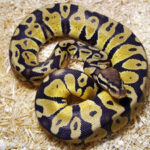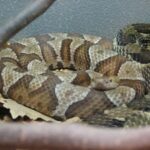When you first get your snake locate a veterinarian who treats reptiles. Check with pet shops that sell snakes and the yellow pages of your phone book. If your snake should get sick, you don’t want to be making frantic phone calls trying to find a veterinarian.
Hopefully, you’ll never need to call that veterinarian. The keys to keeping your snake healthy are good hygiene and optimum housing conditions.
In care your snake does get sick, listed below are a few of the more common ball python snake illnesses.
Malnutrition: This will occur if your snake doesn’t eat. You may have to resort to force feeding to get your snake to eat.
Burns: Burns should never occur because hopefully you wrapped any incandescent bulbs with wire when you set up the cage. If your snake does get a minor burn, swab it daily with a mild antiseptic. For serious burns put a dressing on the burn and take your snake to the veterinarian.
Ectoparasites: These are parasite that live outside the body. The most common ones snakes will get are ticks and mites. Ticks can be seen when you inspect your snake and are fairly easy to remove. First, put a small amount of Vaseline or alcohol on the tick. This will loosen the tick after a few minutes. Then, using your fingers, tweezers, or tick remover, gently pull the tick out. Mite are more of a problem. They are about the size of a pinhead and difficult to see until there are a lot of them. They can cause stress, shedding problems, anemia, loss of appetite,and in some cases death. The good news is they are easy to get rid or. Simply put a piece of fly paper (No Pest Strip) in a perforated container (so your snake doesn’t come in contact with it) and hang it in your snake’s cage. Wait three days and take the strip out of the cage. Repeat in ten days to kill any newly hatched mites.
Endoparasites: These are parasites (worms) found inside your snake. Just about all wild snakes have endoparasites, a good reason not to buy a wild captured snake. Your veterinarian can determine if your snake has worms by looking at a fecal sample under the microscope. If worms are present he will then treat your snake.
Abscesses: An abscess is a lump under the skin. It occurs when the skin has been damaged (like from a mouse bite if you feed your snake live mice) an an infection sets in. Don’t try to treat this yourself. Take your snake to the vet. The vet will probably treat it with antibiotics or in severe cases; he will surgically open the abscess, clean it, and then stitch it back up.
Salmonellosis: This is an intestinal disease which can be passed from snakes to people. To make certain you don’t catch this from your snake, thoroughly wash your hands after every time you handle your snake or clean his cage. If your snake has watery, green-colored, stinky feces, he most probably has salmonellosis.
Mouth Rot: This disease is caused by stress, mouth injuries, or living in a dirty cage. If your ball python has mouth rot you will see patches of white cheesy-looking gunk along his gums. In severe cases, the snake’s lips may be forced apart. To treat this, use cotton swabs to clean the mouth and then wash with hydrogen peroxide. Do this every day until the mouth is back to normal. It may take up to two weeks for mouth rot to clear up.
Respiratory Infections: They occur when snakes are kept in cages with low temperatures. Symptoms are wheezing and gaping of the mouth (don’t confuse this with a yawn), lack of appetite, and nasal discharge. To treat turn up the heat in your snake’s cage. If he doesn’t get better, all your veterinarian, your snake may need antibiotics.
Stomach Rot: This occurs when a snake lives in a dirty cage and gets urine burn on his stomach. The stomach scales will get bubbles. The stomach turns brownish or reddish and get crusty. Take your snake to your vet to be treated.
If you buy a healthy snake, keep his cage clean and at the correct temperature and humidity levels, trips to the vet can be avoided.





